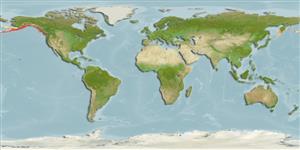Environment: milieu / climate zone / depth range / distribution range
بوم شناسي
دريايي نزديك كف زي; تغييرات عمق 0 - 225 m (Ref. 50610). Temperate; 66°N - 46°N
Northeast Pacific: Bering Sea to southern Puget Sound, Washington, USA.
Size / Weight / سن
Maturity: Lm ? range ? - ? cm
Max length : 8.3 cm TL جنس نر / بدون خواص جنسي; (Ref. 2850)
توصيف مختصر
كليدهاي شناسايي | ريخت شناسي | ريخت ستجي بوسيله انداره گيري
خارهاي باله پشتي (کل) : 22; شعاع نرم باله پشتي (کل) : 15; خارهاي باله مخرجي: 0; شعاع نرم باله مخرجي: 14 - 15. Dorsal spines and rays covered with skin; caudal rounded; pelvic fins partly attached to body (Ref. 6885). Color variable, changing rapidly; translucent pink to gray or brown on dorsal surface, lighter on fins; pectoral fins pale or bright orange; some dark spots on fins and vague darker markings on body; sometimes spotted; eyes orange (Ref. 6885).
Occurs in rocky areas, among sponges; also found on soft bottoms (Ref. 2850).
Life cycle and mating behavior
بلوغ | تولید مثل | تخم ریزی | تخم ها | Fecundity | توزاد ( لارو)
Eschmeyer, W.N., E.S. Herald and H. Hammann, 1983. A field guide to Pacific coast fishes of North America. Boston (MA, USA): Houghton Mifflin Company. xii+336 p. (Ref. 2850)
وضعيت در فهرست قرمز IUCN (Ref. 130435: Version 2024-1)
خطر برای انسان ها
Harmless
استفاده انسانی
ابزارها
گزارش های ويژه
بارگيری XML
منابع اينترنتي
Estimates based on models
Preferred temperature (Ref.
123201): 1.6 - 8.6, mean 5.6 °C (based on 233 cells).
Phylogenetic diversity index (Ref.
82804): PD
50 = 0.5005 [Uniqueness, from 0.5 = low to 2.0 = high].
Bayesian length-weight: a=0.00389 (0.00180 - 0.00842), b=3.12 (2.94 - 3.30), in cm total length, based on all LWR estimates for this body shape (Ref.
93245).
Trophic level (Ref.
69278): 3.2 ±0.5 se; based on size and trophs of closest relatives
Fishing Vulnerability (Ref.
59153): Low vulnerability (10 of 100).
